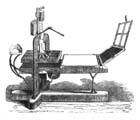Buonaparte-phobia, or Cursing Made Easy
to the Meanest Capacity
Introduction
In 1815, shortly after Napoleon's escape from Elba and his subsequent final defeat at Waterloo, Hone published a broadside called Buonaparte-phobia. The principal target of this parodic satire was John Stoddart, then chief editor and lead-writer for The Times of London. Stoddart had distinguished himself by the virulence of his anti-Napoleonic rhetoric, and the bulk of Hone's parody is made up of curses and epithets drawn directly from Stoddart's columns. It was through this broadsheet, incidentally, that Stoddart earned the epithet "Dr. Slop," a nickname he was unable to shake even in his later work as a conservative journalist and founder of the conservative "Consitutional Association."
Though it comes very early in Hone's career as a pamphleteer and parodist, Buonaparte-phobia already demonstrates some of the sophistication of his technique. For instance, the original publication took the form of a three-column broadsheet with its title and banner designed in imitation of The Times itself. In other words, the material form of the publication contributes significantly to the parody's effect. In addition, the original has a prominent by-line announcing that the work is "By the Editor of 'The Times.'" Since much of the language of the parody is taken from Stoddart himself, the by-line is at least partly true; Hone has, in effect, managed to turn Stoddart's own rhetoric back on itself, thus revealing the manic prejudice that is its prime motivation. And finally, Hone borrows the fundamental dialogue form of the parody from Sterne's gently comical Tristram Shandy, a setting that serves further to heighten the ridiculous extremes of Stoddart's language.
Hone reissued Buonaparte-phobia in 1820, this time set in traditional octavo pamphlet format, with a new Preface and slightly retitled as Buonaparte-phobia: The Origin of Dr. Slop's Name. This new publication was likely sparked by Stoddart's recent activities with the repressive "Consitutional Association" (Hone called it the "Bridge-Street Gang") and his editorship of a paper called The New Times. The text of the parody in this electronic version is taken from the 1820 edition. I have checked it against the original broadsheet; there are no substantial differences in wording, though the emphatic and often idiosyncratic type fonts do vary slightly. Sadly and inevitably, however, neither Hone's 1820 reissue nor an electronic edition like the present can capture the essential materiality of the original broadsheet publication.
The present electronic text consists of a full transcription of the text (including the 1820 Preface). The html text is linked throughout to page-scan images from the octavo edition which offer a more vivid presentation of the emphatic fonts of the original. I have formatted and linked the page scans so that, readers can, if they wish, simply read the full text in facsimile.
